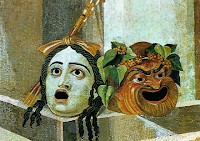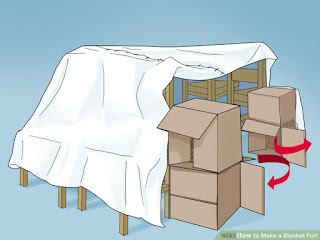Why is it important in ArtAchieve's online art curriculum
-
Do not single out a student for praise. If you praise artwork, you make students depend on praise in order to feel successful.
-
Do ask students what they think of their own work. Help students draw for themselves, rather than for the teacher’s approval.
-
Use the “Time for Reflection” as an opportunity for students to learn to evaluate their own work.
-
Do not draw on students’ paper. When you draw on a student’s work, you make that drawing your own.
-
Do draw on your own scratch paper if you want to demonstrate how to do a certain technique.
There is something private about art classes.
We will stumble if others interfere in our art work.

For example, many years ago, I was creating masks for a theatre production, and a student who was watching asked if she could make a mask too. I gladly accepted the help, and the student started forming the clay mold over which the mask would be formed. Her mask, however, was not as dramatic as the director was requesting, so to explain what needed to be done I dug my fingers into her clay to make bigger contrasts in the shape.
|

|
|
https://en.wikipedia.org/wiki/Mask
|
Doing so was a mistake.
-
I could have demonstrated on my own clay.
-
I could have shown her sketches of the conceptual ideas.
-
I could have used a fresh lump of clay to show what needed to be done.
But I didn’t. Instead, I invaded both her territory and her creation and made it my own.
The student was horrified. As I should have anticipated, she soon left the theater shop and never returned to work.
Art needs to be a place where things can be “mine,”
-
Where kids are the masters of what they are doing
-
Where kids can express their uniqueness
-
Where kids can decide what works they make public and what will remain private.
|

|
|
http://www.wikihow.com/Make-a-Blanket-Fort
|
That shouldn’t surprise us. Art is play: notice how much children like creating private play spaces:
-
Tents made of blankets that hang over chairs
-
Spaces under tables
-
Spaces inside large cardboard boxes.
All of these provide a place away from adult interference, a place to explore, imagine, and dramatize situations unimpeded.
That said, for some kids, especially the kids who worry about “doing art ‘right,’” it might be helpful to set aside a space that says that art class is their chance for them to exercise THEIR imagination.
It might be a small table inside a cardboard box, it might be a suitcase with their supplies and finished work, it might be a lunchbox that is decorated and closed for privacy.
Learning to be a creative, playful, expressive artist often requires time to be alone and work alone, and a space that provides privacy may be the key for some kids’ budding talents.
Give your students a chance to enjoy some artistic playfulness: provide them with some art lessons.
Why is it important in ArtAchieve's online art curriculum
-
Do not single out a student for praise. If you praise artwork, you make students depend on praise in order to feel successful.
-
Do ask students what they think of their own work. Help students draw for themselves, rather than for the teacher’s approval.
-
Use the “Time for Reflection” as an opportunity for students to learn to evaluate their own work.
-
Do not draw on students’ paper. When you draw on a student’s work, you make that drawing your own.
-
Do draw on your own scratch paper if you want to demonstrate how to do a certain technique.
There is something private about art classes.
We will stumble if others interfere in our art work.

For example, many years ago, I was creating masks for a theatre production, and a student who was watching asked if she could make a mask too. I gladly accepted the help, and the student started forming the clay mold over which the mask would be formed. Her mask, however, was not as dramatic as the director was requesting, so to explain what needed to be done I dug my fingers into her clay to make bigger contrasts in the shape.
|

|
|
https://en.wikipedia.org/wiki/Mask
|
Doing so was a mistake.
-
I could have demonstrated on my own clay.
-
I could have shown her sketches of the conceptual ideas.
-
I could have used a fresh lump of clay to show what needed to be done.
But I didn’t. Instead, I invaded both her territory and her creation and made it my own.
The student was horrified. As I should have anticipated, she soon left the theater shop and never returned to work.
Art needs to be a place where things can be “mine,”
-
Where kids are the masters of what they are doing
-
Where kids can express their uniqueness
-
Where kids can decide what works they make public and what will remain private.
|

|
|
http://www.wikihow.com/Make-a-Blanket-Fort
|
That shouldn’t surprise us. Art is play: notice how much children like creating private play spaces:
-
Tents made of blankets that hang over chairs
-
Spaces under tables
-
Spaces inside large cardboard boxes.
All of these provide a place away from adult interference, a place to explore, imagine, and dramatize situations unimpeded.
That said, for some kids, especially the kids who worry about “doing art ‘right,’” it might be helpful to set aside a space that says that art class is their chance for them to exercise THEIR imagination.
It might be a small table inside a cardboard box, it might be a suitcase with their supplies and finished work, it might be a lunchbox that is decorated and closed for privacy.
Learning to be a creative, playful, expressive artist often requires time to be alone and work alone, and a space that provides privacy may be the key for some kids’ budding talents.
Give your students a chance to enjoy some artistic playfulness: provide them with some art lessons.
Why is it important in ArtAchieve's online art curriculum
-
Do not single out a student for praise. If you praise artwork, you make students depend on praise in order to feel successful.
-
Do ask students what they think of their own work. Help students draw for themselves, rather than for the teacher’s approval.
-
Use the “Time for Reflection” as an opportunity for students to learn to evaluate their own work.
-
Do not draw on students’ paper. When you draw on a student’s work, you make that drawing your own.
-
Do draw on your own scratch paper if you want to demonstrate how to do a certain technique.
There is something private about art classes.
We will stumble if others interfere in our art work.

For example, many years ago, I was creating masks for a theatre production, and a student who was watching asked if she could make a mask too. I gladly accepted the help, and the student started forming the clay mold over which the mask would be formed. Her mask, however, was not as dramatic as the director was requesting, so to explain what needed to be done I dug my fingers into her clay to make bigger contrasts in the shape.
|

|
|
https://en.wikipedia.org/wiki/Mask
|
Doing so was a mistake.
-
I could have demonstrated on my own clay.
-
I could have shown her sketches of the conceptual ideas.
-
I could have used a fresh lump of clay to show what needed to be done.
But I didn’t. Instead, I invaded both her territory and her creation and made it my own.
The student was horrified. As I should have anticipated, she soon left the theater shop and never returned to work.
Art needs to be a place where things can be “mine,”
-
Where kids are the masters of what they are doing
-
Where kids can express their uniqueness
-
Where kids can decide what works they make public and what will remain private.
|

|
|
http://www.wikihow.com/Make-a-Blanket-Fort
|
That shouldn’t surprise us. Art is play: notice how much children like creating private play spaces:
-
Tents made of blankets that hang over chairs
-
Spaces under tables
-
Spaces inside large cardboard boxes.
All of these provide a place away from adult interference, a place to explore, imagine, and dramatize situations unimpeded.
That said, for some kids, especially the kids who worry about “doing art ‘right,’” it might be helpful to set aside a space that says that art class is their chance for them to exercise THEIR imagination.
It might be a small table inside a cardboard box, it might be a suitcase with their supplies and finished work, it might be a lunchbox that is decorated and closed for privacy.
Learning to be a creative, playful, expressive artist often requires time to be alone and work alone, and a space that provides privacy may be the key for some kids’ budding talents.
Give your students a chance to enjoy some artistic playfulness: provide them with some art lessons.




